 Mrs. T and I have just added a new piece to the Teachout Museum, a posthumous impression of an unsigned drypoint by Berthe Morisot, a member of the original circle of French Impressionists. It was made in 1888 or 1889 and is variously known as “Jeune fille au chat,” “Fillette au chat (Julie Manet),” and “Young Girl with a Cat, after a portrait of Julie Manet by Renoir.” It is, as the third of these titles indicates, based on an 1887 painting by Renoir called “Julie Manet” that is owned by the Musée d’Orsay. The long version of the title is the one used by the Metropolitan Museum of Art, which acquired its copy in 1922.
Mrs. T and I have just added a new piece to the Teachout Museum, a posthumous impression of an unsigned drypoint by Berthe Morisot, a member of the original circle of French Impressionists. It was made in 1888 or 1889 and is variously known as “Jeune fille au chat,” “Fillette au chat (Julie Manet),” and “Young Girl with a Cat, after a portrait of Julie Manet by Renoir.” It is, as the third of these titles indicates, based on an 1887 painting by Renoir called “Julie Manet” that is owned by the Musée d’Orsay. The long version of the title is the one used by the Metropolitan Museum of Art, which acquired its copy in 1922.
We saw Morisot’s print for the first time on a recent visit to Pittsburgh’s Carnegie Museum of Art, where it is proudly hung. Here’s what the Carnegie Museum has to say about “Jeune fille au chat” in its online catalogue:
Known primarily for her paintings of domestic life, Berthe Morisot began experimenting with printmaking in the late 1880s at the encouragement of her Impressionist colleagues. In this drypoint, Morisot lightly sketches her daughter, Julie Manet, a frequent subject of her works. She was Morisot’s only child and the niece of Édouard Manet. Beginning around 1888, Morisot made 12 known etching and drypoint plates, which were deposited with renowned publisher Ambroise Vollard after her death in 1895. Vollard had small editions of her plates printed. The two dots, at the upper center and the lower center, indicate that the print belongs to the posthumous edition produced by Vollard.
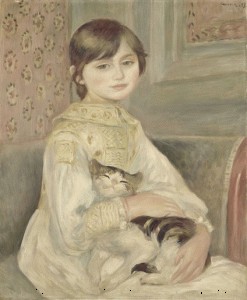 Renoir’s original is lovely and characteristic, but Morisot has in my opinion improved on it by turning his painting into a drypoint, in the process making it at once crisper and (dare I say it?) less obviously sentimental. Julie Manet recalled that Renoir painted the portrait “in small sections, which was not his usual way of working. I thought it was a good resemblance, but when Degas saw it he complained: ‘By doing round faces, Renoir produces flower pots.’”
Renoir’s original is lovely and characteristic, but Morisot has in my opinion improved on it by turning his painting into a drypoint, in the process making it at once crisper and (dare I say it?) less obviously sentimental. Julie Manet recalled that Renoir painted the portrait “in small sections, which was not his usual way of working. I thought it was a good resemblance, but when Degas saw it he complained: ‘By doing round faces, Renoir produces flower pots.’”
I might add that Renoir’s Julie, as was his wont, is an idealized vision of a pretty young girl, whereas Morisot’s Julie is a real person, so real that she all but leaps out of the frame. No doubt this has something to do with the fact that Morisot was Julie’s mother: she knew her better.
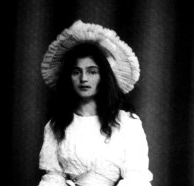 Here’s what I wrote about the print in this space two months ago, a few days after seeing it in Pittsburgh:
Here’s what I wrote about the print in this space two months ago, a few days after seeing it in Pittsburgh:
Morisot tends to get short shrift in discussions of the French impressionists, no doubt in part because she was a woman but also because of the soft-spoken intimacy of her work. The CMA also owns a spectacular Monet water-lily panel in front of which Mrs. T and I lingered, but we came back to “Young Girl with a Cat” twice, and I felt even more strongly on a second viewing that I could look at it every day. Aside from its sheer elegance of execution, I delighted in the sharp features of the young girl portrayed therein. If there is such a thing as a quintessentially French face, Julie Manet had one, and Morisot, her mother, managed to catch it on the etching plate.
When a beautifully framed copy came up for auction in Connecticut this past weekend, I decided to bid on it, and knocked it down for—believe it or not—one hundred dollars. Never let it be said that it isn’t possible to buy classy art on the cheap!



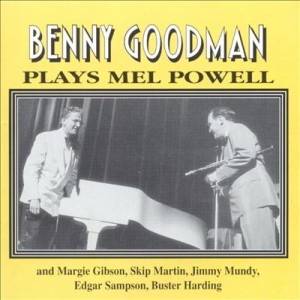 I had occasion the other day to Google
I had occasion the other day to Google 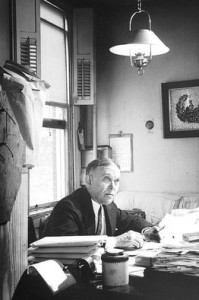 Compared to the true writing machines of the past, of course, I’m a piker. Rex Stout, about whom I’m
Compared to the true writing machines of the past, of course, I’m a piker. Rex Stout, about whom I’m 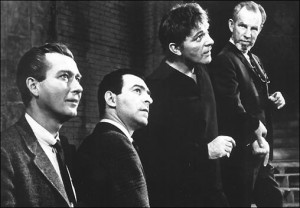 A friend recently sent me a copy of
A friend recently sent me a copy of 
 One reason why it works so well is that Ms. Stone has followed to the letter Stephen Sondheim’s shrewd advice not to stage the musical as “mere camp.” Accordingly, her “women” are men dressed in Milton Berle-style drag. They act like women—sort of—but don’t look like them in the least. Philia (David Turner), the Roman courtesan with whom Hero (Bobby Conte Thornton) falls hopelessly in love, isn’t even pretty and wears a wig that could have come from a dime store. cMs. Stone’s purpose is to present the well-worn dumb-blonde stereotypes utilized by Mr. Sondheim, Larry Gelbart and Burt Shevelove, the authors of “Funny Thing” (as well as Plautus, the third-century Roman playwright on whose farces it is freely based), in a new light. “It feels like an all-male show already because these female roles are male constructs,” she explained in a recent interview. If, then, they are played by male actors whose maleness is immediately obvious to the audience, the absurdity of the stereotypes will become just as obvious.
One reason why it works so well is that Ms. Stone has followed to the letter Stephen Sondheim’s shrewd advice not to stage the musical as “mere camp.” Accordingly, her “women” are men dressed in Milton Berle-style drag. They act like women—sort of—but don’t look like them in the least. Philia (David Turner), the Roman courtesan with whom Hero (Bobby Conte Thornton) falls hopelessly in love, isn’t even pretty and wears a wig that could have come from a dime store. cMs. Stone’s purpose is to present the well-worn dumb-blonde stereotypes utilized by Mr. Sondheim, Larry Gelbart and Burt Shevelove, the authors of “Funny Thing” (as well as Plautus, the third-century Roman playwright on whose farces it is freely based), in a new light. “It feels like an all-male show already because these female roles are male constructs,” she explained in a recent interview. If, then, they are played by male actors whose maleness is immediately obvious to the audience, the absurdity of the stereotypes will become just as obvious.